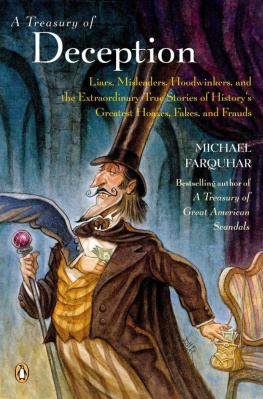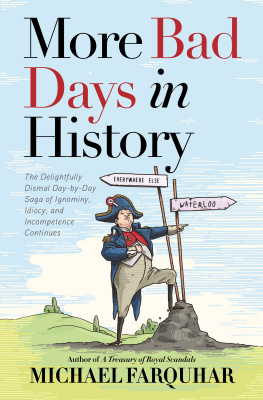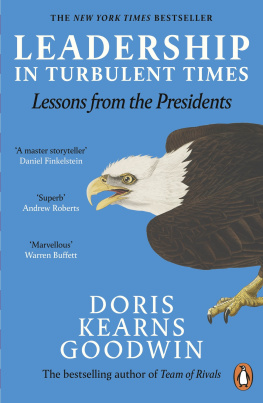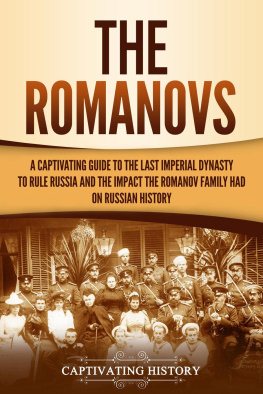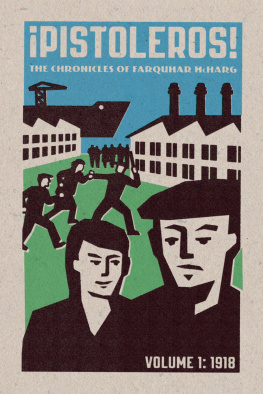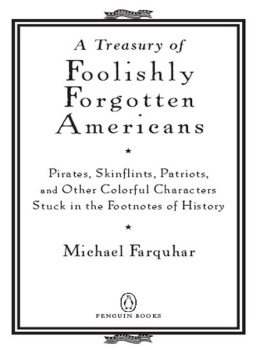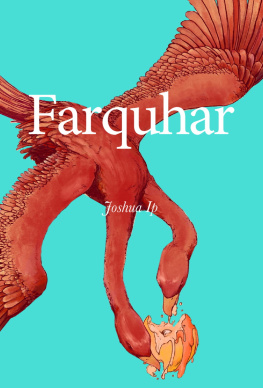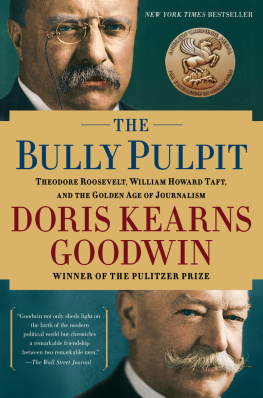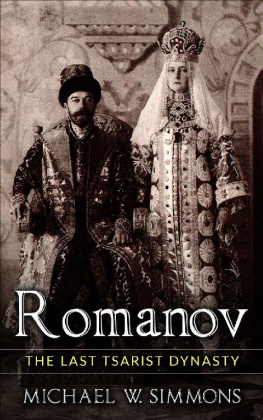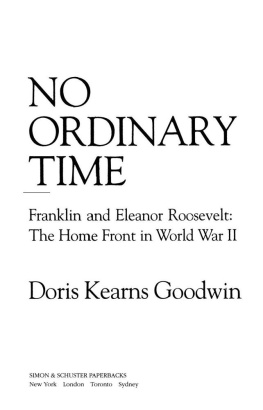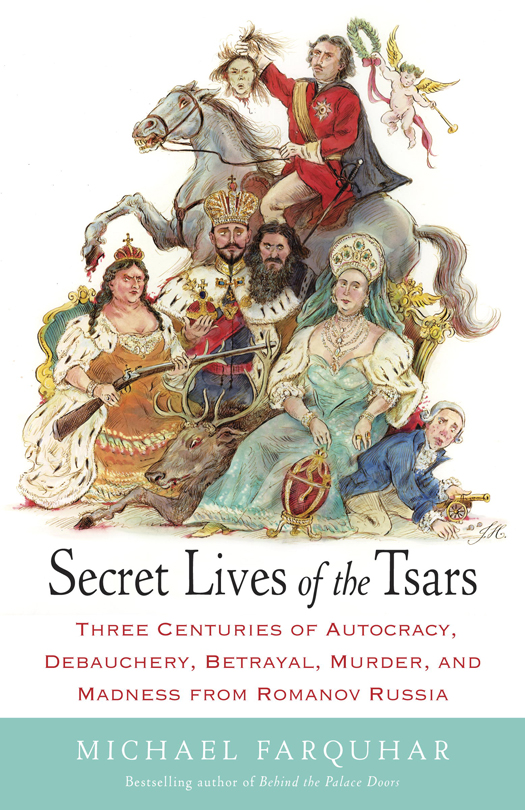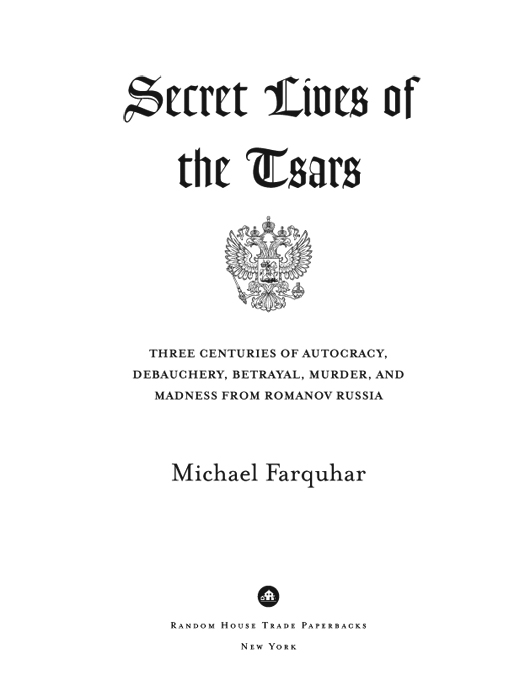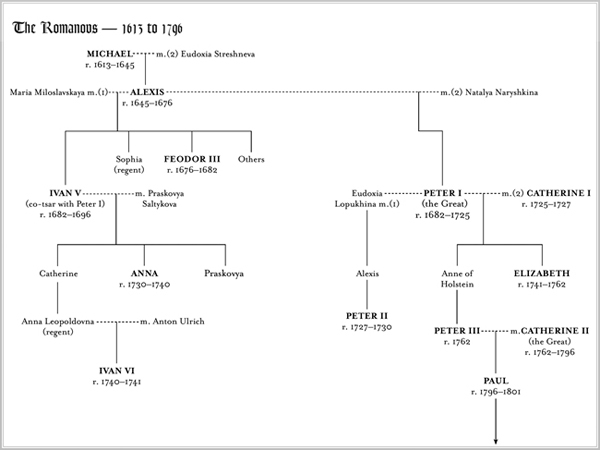To view a full-size version of this image, click HERE.
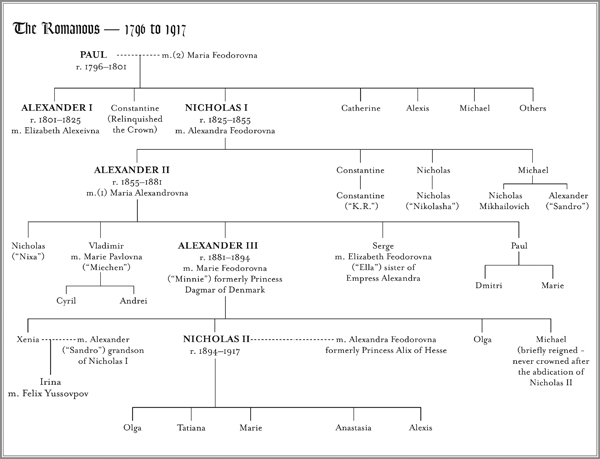
To view a full-size version of this image, click HERE.
CONTENTS
I NTRODUCTORY C HAPTER
The Time of Troubles and the Rise of the Romanovs
C HAPTER 1
Ivan V and Peter I (16821696): One Autocrat Too Many
C HAPTER 2
Peter I (16961725): The Eccentricities of an Emperor
C HAPTER 3
Catherine I (17251727): The Peasant Empress
C HAPTER 4
Anna (17301740): A Bored Estate Mistress
C HAPTER 5
Elizabeth (17411762): The Empress of Pretense
C HAPTER 6
Peter III (1762): Nature Made Him a Mere Poltroon
C HAPTER 7
Catherine II (17621796): Prey to This Mad Passion!
C HAPTER 8
Paul (17961801): He Detests His Nation
C HAPTER 9
Alexander I (18011825): Napoleons Conqueror
C HAPTER 10
Nicholas I (18251855): A Condescending Jupiter
C HAPTER 11
Alexander II (18551881): A Crowned Semi-Ruin
C HAPTER 12
Alexander III (18811894): A Colossus of Unwavering Autocracy
C HAPTER 13
Nicholas II (18941917): An Absolute Child
C HAPTER 14
Nicholas II (18941917): Gliding Down a Precipice
C HAPTER 15
Nicholas II (18941917): A Bloody End
C ONCLUDING C HAPTER
Aftermath
The Time of Troubles and the Rise of the Romanovs
The live animals came hurtling through the air, tossed off a Kremlin tower by the knee-high tyrant-in-training who would one day rule as Ivan the Terrible. There were no consequences for the demented lads behavior then, nor would there be later when, as Russias first crowned tsar, he slaughtered almost the entire city of Novgorodaccentuating the massacre by shoving a number of his victims under the ice of the frozen Volkhov River. Ivan barely blinked when he personally gutted one nobleman after mocking his royal pretensions by dressing him like a king and seating him on a throne, or when he ordered hundreds of his perceived enemies skinned, boiled, burned, or broken in an orgy of retribution on Red Square. Yet while this savage monarch murdered with impunity (which, not surprisingly, made him the favorite tsar of the twentieth-century monster, Joseph Stalin) there was one act of homicidal rage that Ivan IV would deeply regret; a fit of pique that changed the course of Russian history.
When, in 1581, the tsars eldest son had the temerity to object to his fathers kicking his pregnant wife in the stomach, Ivan became so incensed that he clobbered the younger man on the head with his iron staff. Rage instantly turned to regret, though, as the half-crazed sovereign cradled his dying heir in his arms. May I be damned! Ive killed my son! Ive killed my son! he cried. Indeed, he had. And with that bop on the head, Ivan had effectively destroyed the future of the ancient Rurik dynasty of sovereigns who had forged Russia into a nation.
Less than three years after killing his son, Ivan the Terrible was dead as wellfelled by a stroke while playing chess. And though Russia began to recover from his ruinous policies, the relief was only temporary. In fact, Ivan IVs reign of terror turned out to be a mere prelude to a far more devastating era of famine, civil strife, and bloodshed known as the Time of Troubles. During this violently unsettled period, a succession of schemers, opportunists, and even an imposter occupied the Russian throne before young Michael Romanov was elected tsar in 1613 and began a storied royal dynasty that would endure for the next three centuries.
The transfer of power after the death of Ivan IV in 1584 had been peaceful enough; a deceptive lull, as it turned out. The bloody tsar was succeeded by his simple and uninspiring second son, Feodor I. Of mind he has but little or none at all, a Polish envoy wrote of the malformed monarch, who was guided by a group of regents. Among them was Tsar Feodors brother-in-law, Boris Godunov, a shrewd politician and able administrator who emerged as the sole power behind the slow tsars throne.
Early in Feodors reign, Godunov crushed a revolt by the family of one of Ivan the Terribles last wives,youngest son, Dmitri. The tsarevitch (tsars son) and his mother, Maria, were exiled to the small principality of Uglich, and there, in 1591, the eight-year-old boy died under mysterious circumstances, his throat slashed. While Maria and her family loudly blamed their enemy Boris Godunov for Dmitris death, inciting a deadly riot in the process, an investigative commission determined the child had been playing with a knife and fatally wounded himself with it during a seizure. Godunov was officially exonerated, but Dmitri would nevertheless loom large in his future.
In 1598, the enfeebled Tsar Feodor died without an heir, thus ending with a whimper the once-mighty Rurik dynasty. Boris Godunov, who had served as Russias de facto ruler while Feodor merely reigned, was now selected to take his place. After a great show of reluctance, he was crowned amid general acclaim and seemed poised to bring Russia to greatness. Even with a severe economic crisis, crippling taxes, and an emerging policy that bound the majority of the population to the land against their will, Tsar Boris sat securely on his throne. But then the weather got really bad.
Climatic upheavals wrought by the Little Ice Age caused horrific famines during Boris Godunovs seven-year reign. I swear to God that this is the truth, one witness to the disaster reported. I saw with my own eyes people lying on the streets, eating grass like cattle in summer and hay in winter. Some were already dead, with hay and dung in their mouths and also (pardon my indelicacy) had swallowed human excrement. Many dead bodies of people who had perished through hunger were found daily in the streets. Daily hundreds of corpses were gathered up at the tsars command and carried away on so many carts, that to behold it (scarcely to be believed) was grisly and horrible.


